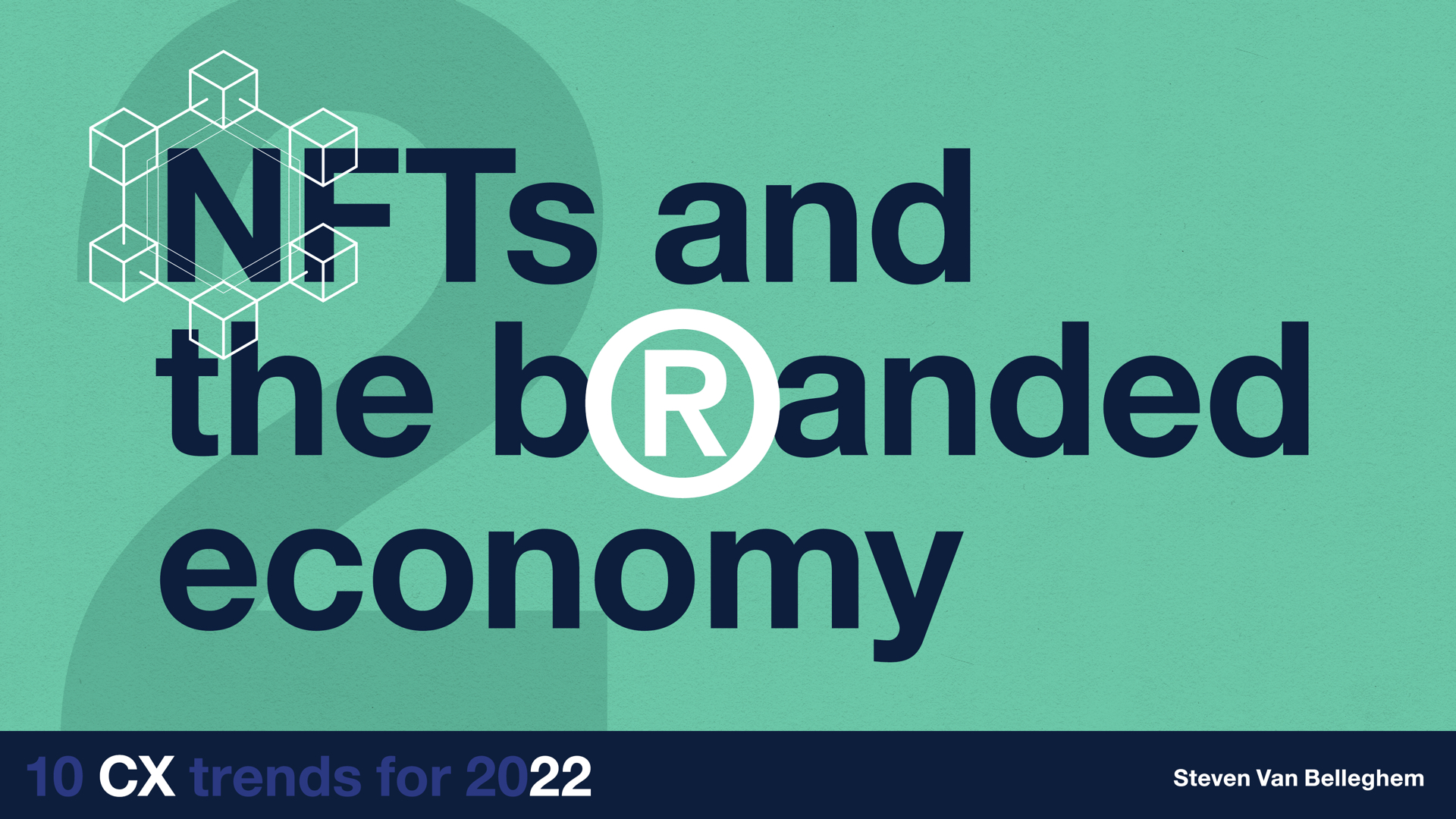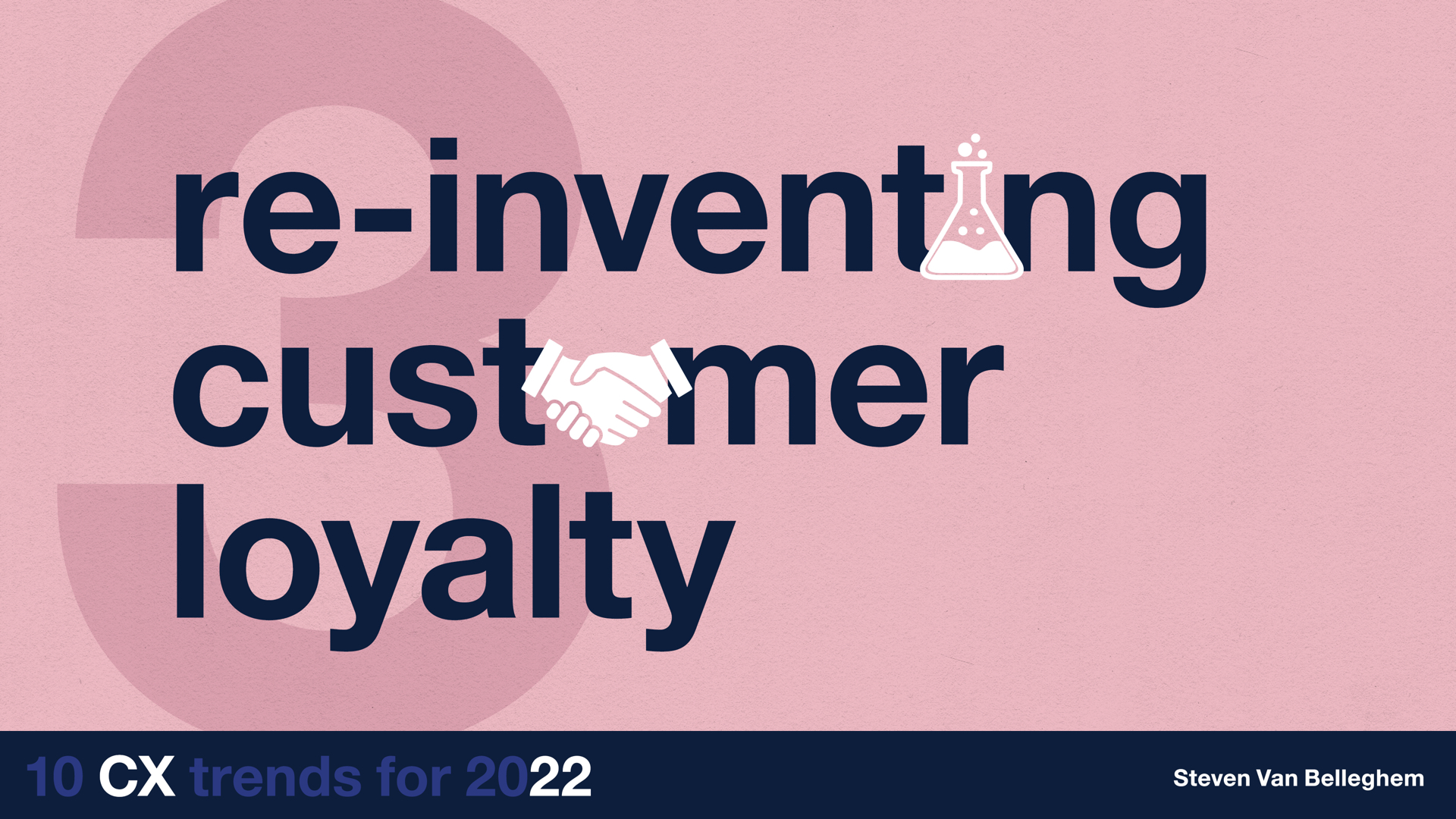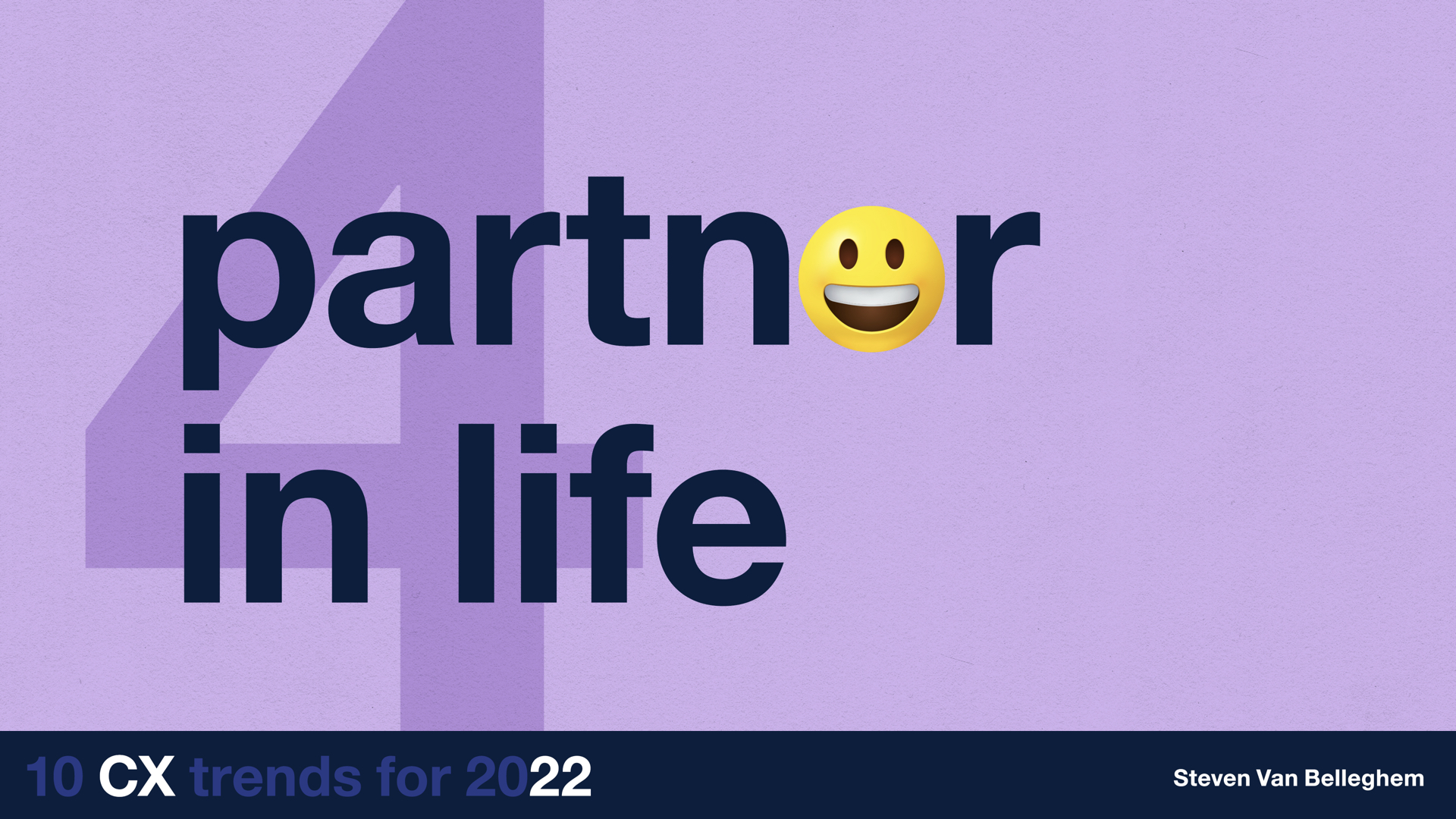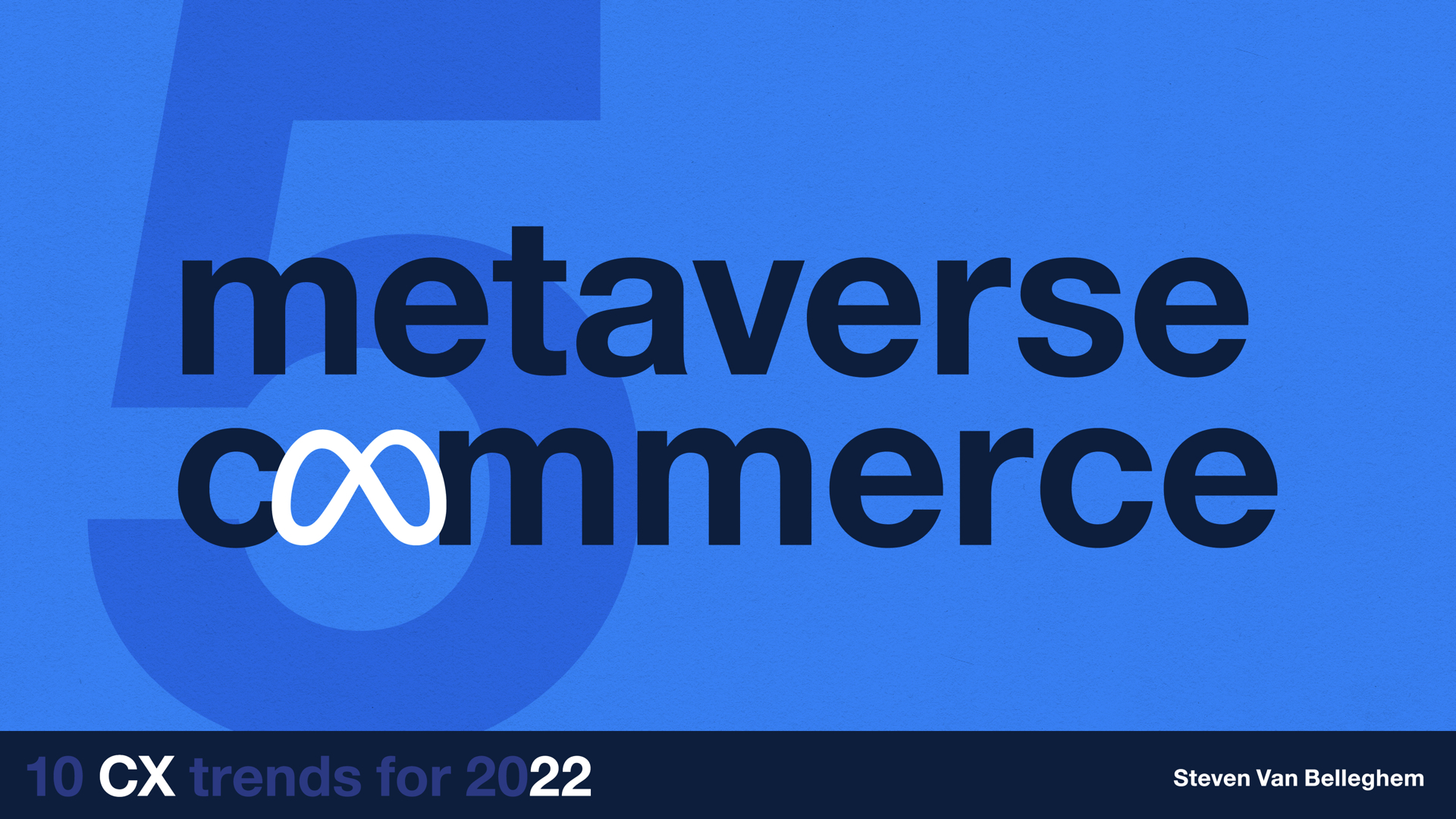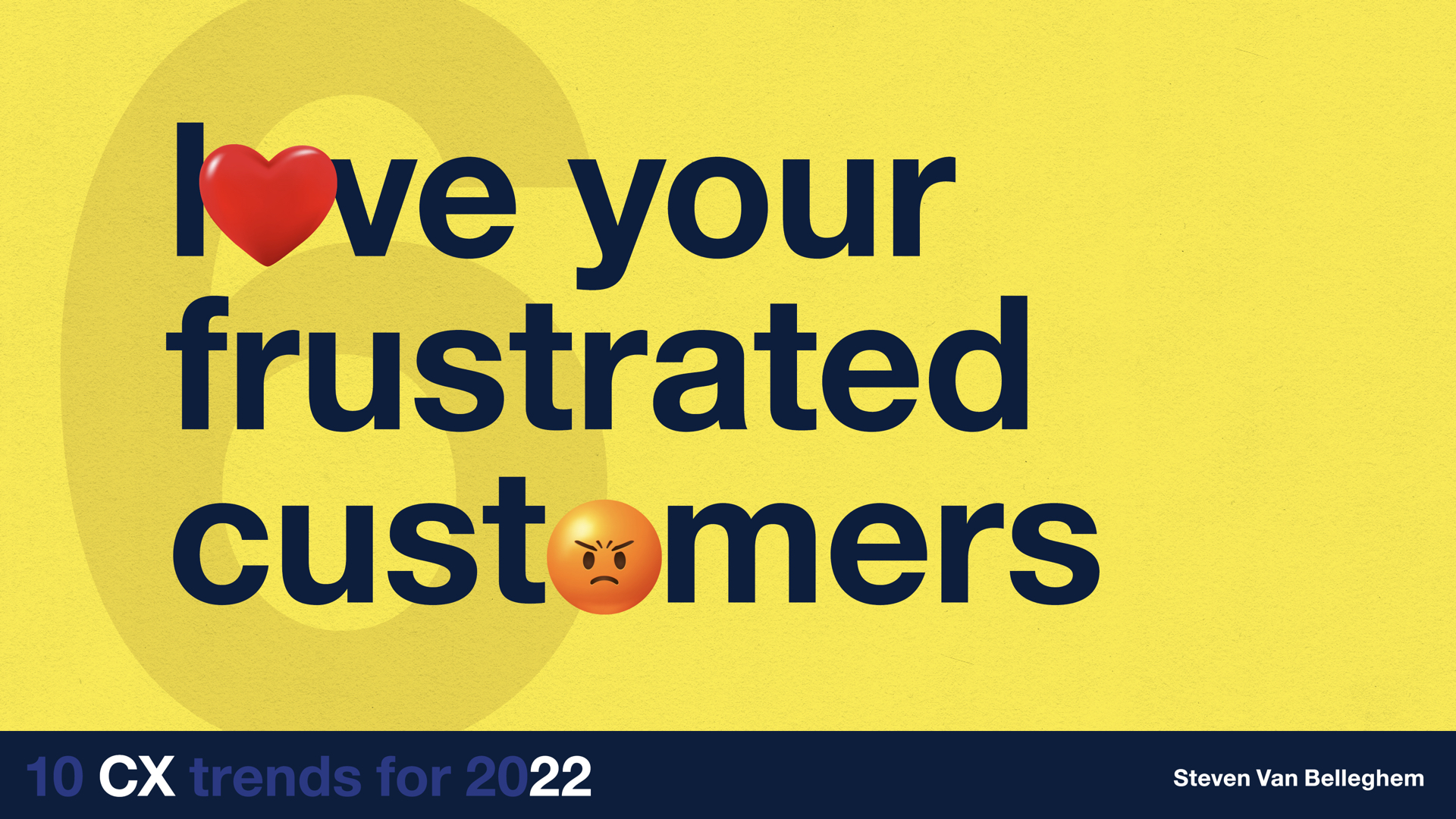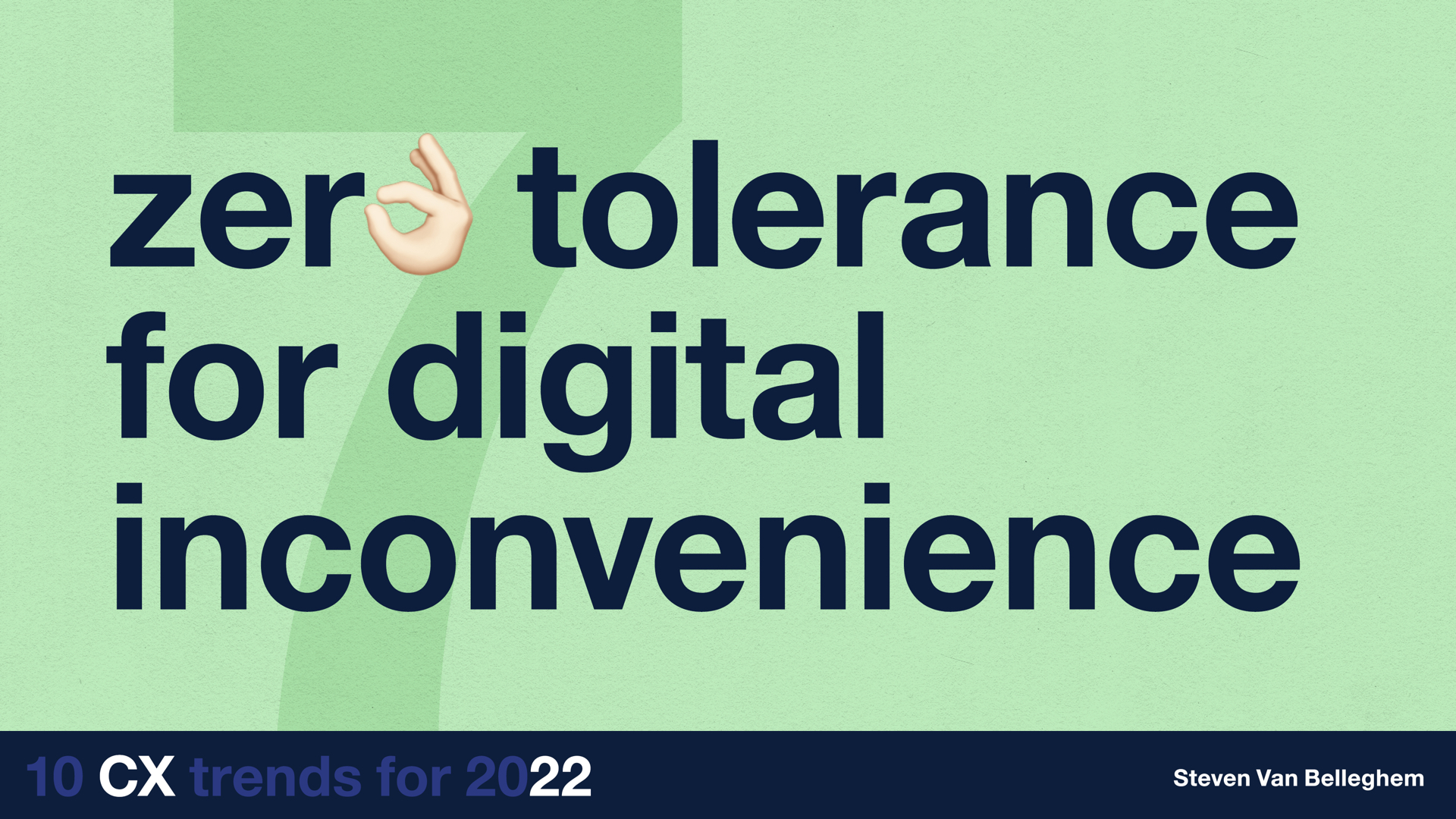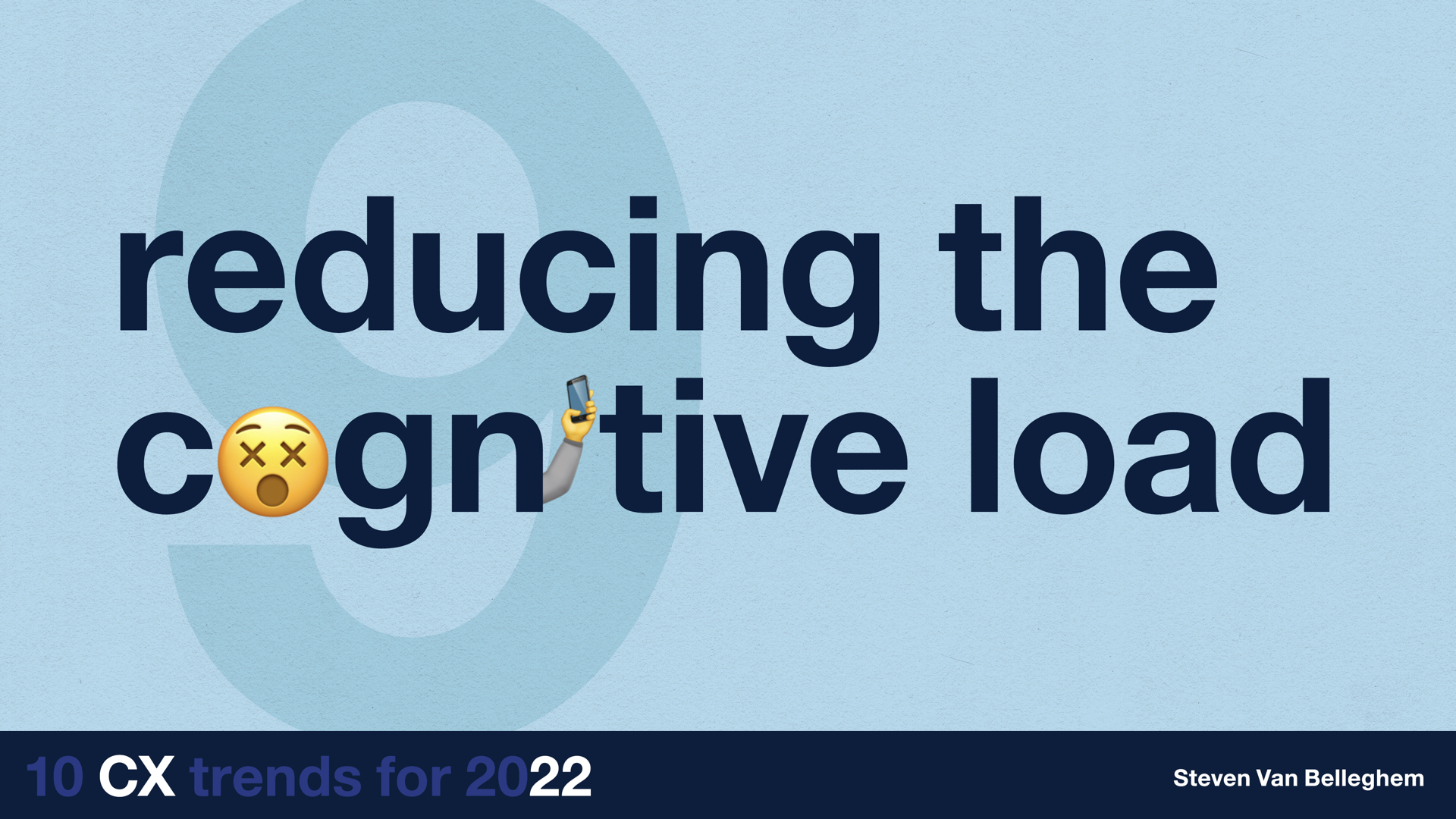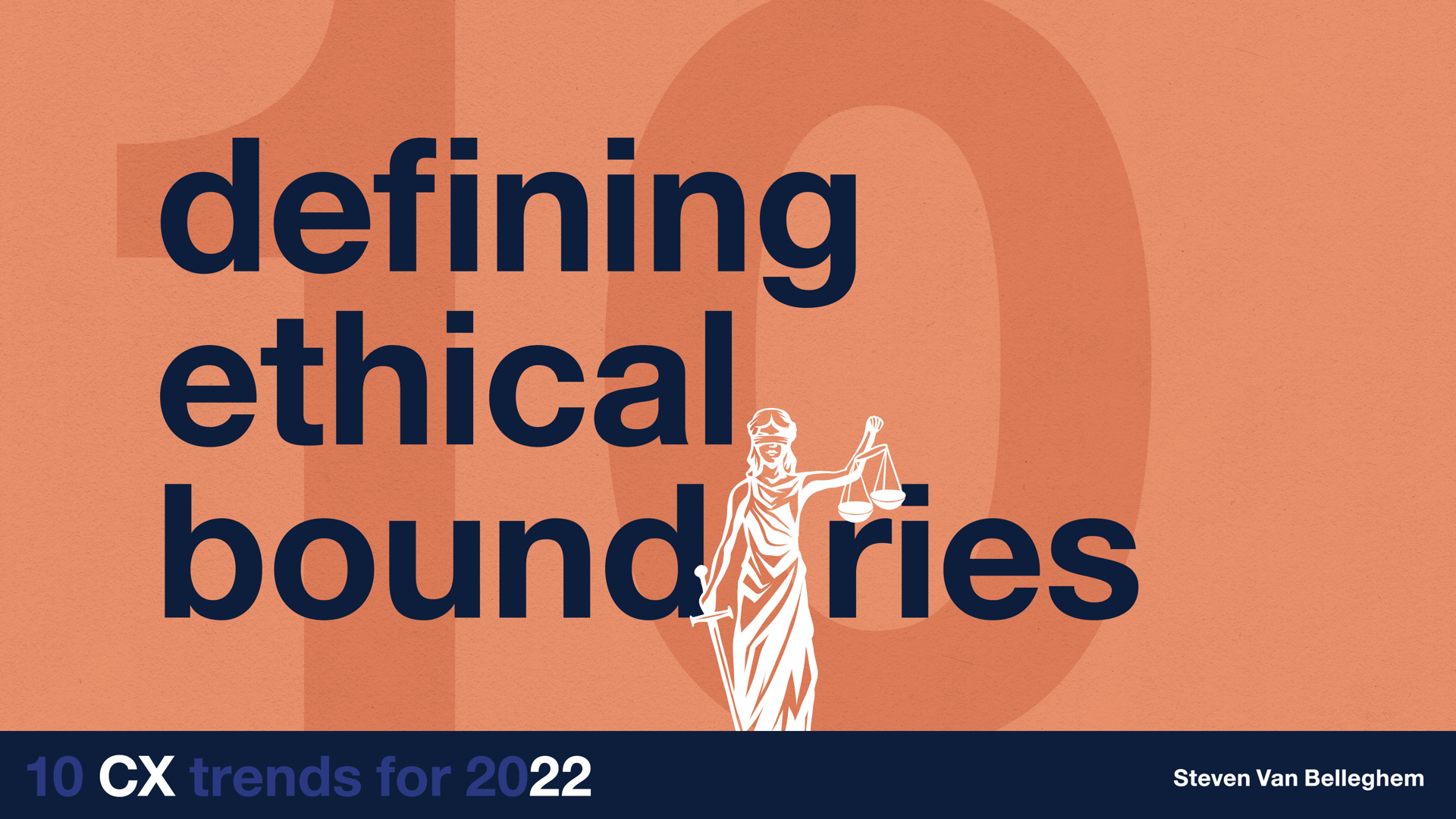10 Customer Experience trends for 2022
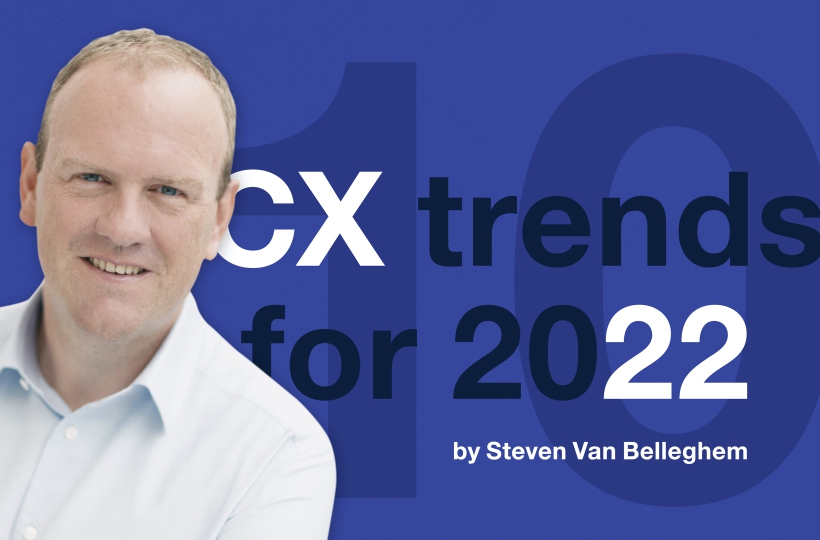
Artificial serendipity
Traditionally, marketers like to make sure that customers can easily find the products and services they are looking for. That’s a no-brainer, of course but perhaps more surprising is that research by the University of Sydney, University of Florida, and Rutgers University recently uncovered that serendipity and seemingly random discoveries can play a huge role in customer satisfaction. They’re not the only ones: research by Facebook in 2020 uncovered that 63 percent of global shoppers enjoyed discovering items they weren’t actively looking for.
Today’s consumers are almost drowning in a sea of (information about) products. The ‘magic’ that comes with finding something unexpected has almost completely disappeared. The pandemic and our (partly temporary) move to the online world and its commerce probably played its part here. But the good news is that CX experts can really work with that knowledge to create more satisfying, enjoyable and serendipitous experiences through positive and unexpected chance encounters.
Examples of this type of ‘artificial’ serendipity (which is in a bit of an oxymoron, I know), are the pleasure that comes with receiving a random selection of products from subscription box services like Birchbox and Stitchfix. Or Netflix introducing a shuffle button that eliminates choice and plays a randomly selected program for the consumer.
In a world of increasingly orchestrated customer experiences, I believe that brands that understand how to stimulate serendipity will set themselves apart.
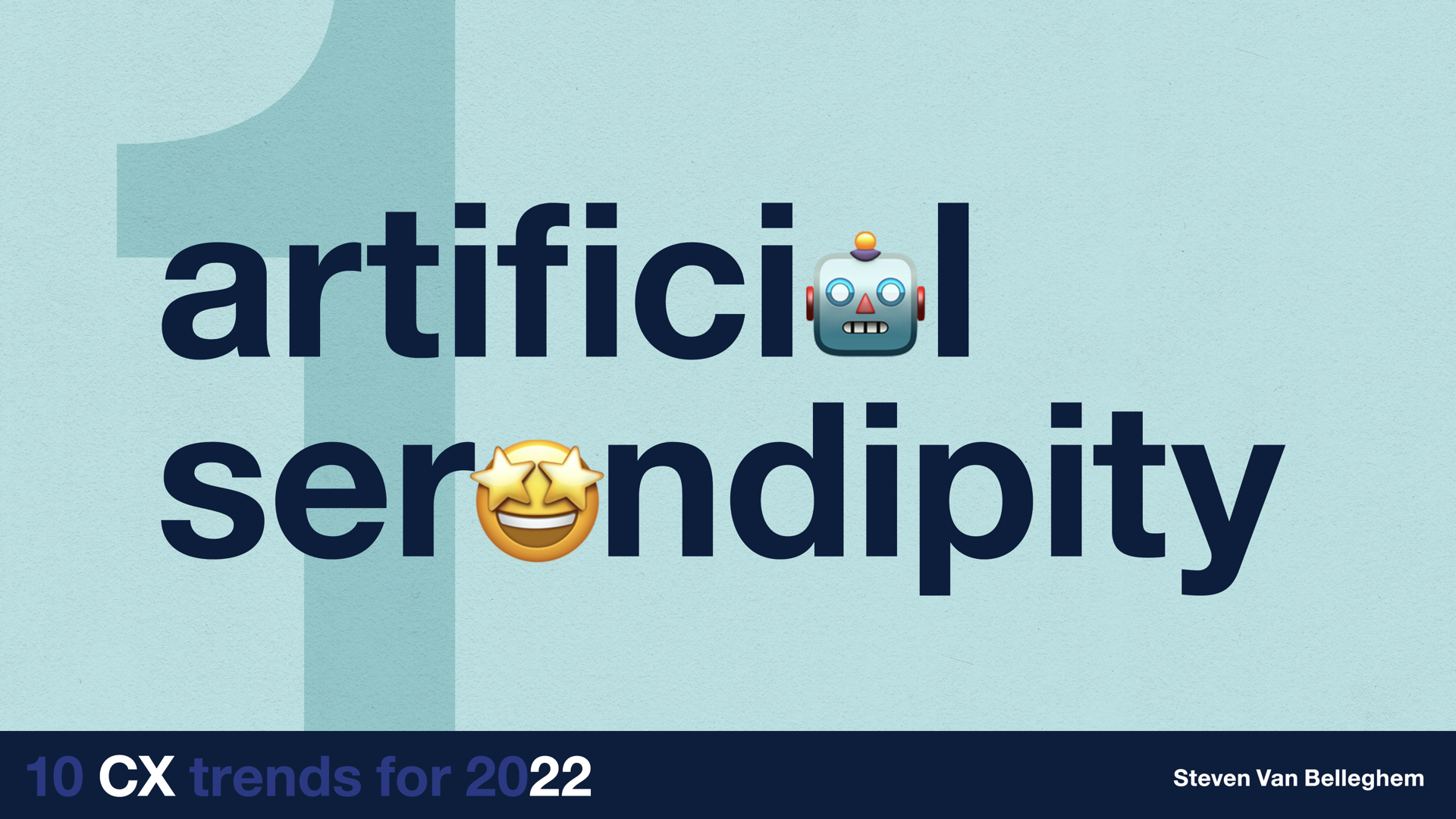
NFTs & the branded economy
This past year, NFTs have become a real hype. If you’re not familiar with the concept: they are ‘one-of-a-kind’ assets in the digital world that can be bought and sold like any other piece of property but lack a tangible form of their own. People really started to notice the phenomenon with the sale of Mike Winkelmann’s – aka Beeple’s – digital piece of art ‘EVERYDAYS: THE FIRST 5000 DAYS’ for a whopping $69,346,250. And then or course there was Jack Dorsey, CEO of Twitter and Square, who sold his first tweet “just setting up my twttr” as an NFT for over $2.9 million.
The NFT trend is still mostly a gimmick but I believe that they hold the promise to move beyond the current ‘exciting’ collectibles phase and fundamentally change the customer loyalty landscape. The reason is that they can hold smart contracts, which could play an important role in boosting customer engagement. Kings of Leon, for instance, were the first band to release an album as an NFT and their tokens – also including 18 unique-looking golden tickets – unlock special perks like limited-edition vinyl and front row seats to future concerts. Not surprisingly, CX guru Gary V, is also experimenting heavily with this: his VeeFriends collection of NFT animal drawings includes a smart contract offering, for instance, exclusive access to his events.
But the most interesting potential of NFTs truly lies in the concept of branded economies, which could trigger a genuine paradigm shift in customer loyalty. Today, most loyalty systems are out of balance: we all know that more benefits go to the company than to the customer. NFTs, on the other hand, will involve the customers a lot more, who will then become part of the journey. For instance, as a frequent flyer, if I had an NFT stake in a company, we will both have a shared interest instead of contradictory ones. If the company does well, the value of the NFT will rise and then I will do well too. If they win, I win. If they lose, I do too. And so, as a customer, I benefit when the brand performs better, making me an ambassador.
Keep an eye on NFTs. They have extraordinary potential to disrupt the future of CX.
Reinventing customer loyalty
Customers and listeners often ask me “Steven, how can I make my customers more loyal?”. I always tell them that they need to change their mindset and reverse the question if they want to be successful. The actual question should be “How can my company or my brand show loyalty to its customers so they will ‘reward’ us with their loyalty”.
As stated above, today’s loyalty programs are way out of balance, offering a lot more benefits to the company than the consumer. The frequent flyer example I quoted where the company gets all the money and the customer gets mere crumbs like shorter waiting lines is the perfect example of ‘how not to’. Airlines are not loyal to their customers but they should be.
An emerging trend that I see today is that we all need to evolve towards shared interest, of which the NFT example I gave earlier is a perfect case in point. Brands benefit from happy customers and the customers benefit when the brand does well: all of them – the company’s shareholders, employees and customers – basically strive for the same thing. It’s a positive sum game instead of the classic zero sum game. Shein, for instance, has a very interesting take on positive sum loyalty by rewarding customers who act as true ambassadors.
I believe that in the coming years loyalty will evolve from a one way street into a matter of shared interest.
Partner in Life
The Partner in Life concept is one of the three pillars of my book ‘The Offer You Can’t Refuse’. Published almost a year ago, the concept remains as relevant as ever, especially in Covid times where customers really expect brands to help them realize their hopes and dreams. Partner in Life is about brands moving beyond the customer journey and assisting their customers in their life journey, helping them get rid of negative energy and create positive energy. It’s about optimizing the emotional relationship with their customers.
An example is Samsung’s smart fridge, which stimulates users to select the products that are almost overdue, thereby saving money and helping to reduce food wastage. Or insurer Centraal Beheer’s Handyman app, which is a kind of Uber for odd-job men: they call on their existing network of technical experts from many different fields that they have been working with for years and use them for repairs carried out within the scope of insurance claims. Now the skills of these craftsmen are being exploited to create an added value that has nothing to do with insurance.
The reason why we see this trend is gaining momentum is data, of course. Digital products produce a treasure trove of data about customers and it’s very ‘easy’ to build services based on these data-flows. Take Samsung’s smart fridge, for instance: it could ‘only’ order new products when they are no longer on stock in the fridge. But now that the fridge can gather so much data – the environmental and health impact of a product, the due date is, etc. – it has the possibility to build a variety of dietary, environmentally friendly and efficient services on top of its smart product. And in doing so, it no longer just offers an efficient product, but a product that helps users become more healthy and sustainable: a product that shows its loyalty to customers by helping them with their emotional journey as well.
That transition is not just about changed customer behavior (though it certainly is about that), but just as much because the data facilitates it. It’s much harder to become a Partner in Life with products only but the ‘Everything-as-a-Service’ trend triggered by the data economy will be a big driver of this Partner in Life concept.
Metaverse Commerce
The battle for the Metaverse is on since this year. We all know that Facebook – uhm, Meta – is investing a lot of money in building a VR platform for social, i.e. business as well as commerce purposes: at least $10 billion in the coming years, to be precise. It’s also hiring 10,000 extra people in Europe to work on that platform. A few days after Facebook Connect announced its big plans with the metaverse, Satya Nadella told us that Microsoft is also working on a new collaborative VR metaverse platform called Mesh in Microsoft Teams which should be available next year. It’s part of a big effort to combine the company’s mixed reality and HoloLens work with meetings and video calls that anyone can participate in thanks to animated avatars.
Even though I really believe that it will take quite a while for these types of VR platforms to become ubiquitous – due to, among other things, UX (VR goggles are heavy and unstable) and financial reasons (they are still pretty expensive) – I also think that companies will have to start thinking about performing commerce and marketing inside the metaverse. Mark Zuckerberg talked a lot about the possibilities of commerce inside the metaverse – like buying clothes for your avatar – and expects Meta to generate “hundreds of billions of dollars of digital commerce in the next 10 years”.
This is taking social commerce – which is already popular in China as well as on Instagram and Pinterest – to a whole new level: one that is so much more immersive, contextual and spatial. So it’s important to start thinking about how you can expand your offering to that platform too. Maybe Zalando could launch a purely virtual clothing collection for the metaverse. Maybe some exclusive items used or worn in the Metaverse – custom-made for influencers and movie stars and then sold off as collectibles afterwards – could be NFTs. In fact, talking about virtual apparel, Nike’s trademark applications indicate that it might want to offer virtual goods like sneakers as part of video games and other online platforms. Or architects could design custom-made rooms (as NFTs?) for people in the metaverse and, as a bonus, build these rooms for people in the real world as well. And what about the marketing side of things? Would there be metadata for people to click on when they see a fun looking pet they would like to buy? The possibilities are literally endless here and it’s the companies that best understand them now – before they become a reality – that will have the upper hand.
Love your frustrated customers
We all know that negative customer experiences spread al lot faster than positive ones. The scariest aspect is that just 1 in 26 negative experiences are shared with the company, which would then be in a position to do something about it.
Companies often wrongly assume that customers who are not complaining are satisfied customers but in reality, the absence of negative feedback is not synonymous with happiness. Especially in times of abundant choice, it is crucial for companies to keep a close eye on customers. Find the satisfied ones, determine why they are happy and use that to make the experience even better. But above all, find the dissatisfied customers, try to understand them, learn from your mistakes and then do everything you can to improve your performance.
According to a report by PwC, 1 in 3 (formerly) loyal customers leaves a brand after one bad experience. See that as a challenge instead of a threat and turn their frustration into better solutions. I believe that more than ever brands will understand that mistakes, frictions and frustrations are golden opportunities. Love your frustrated customers. They are your greatest source of information.
Zero tolerance for digital inconvenience
If there is one thing that the Covid crisis has cemented then it surely is zero tolerance for digital inconvenience. Confined to our homes with nowhere to go but online, we’ve lost all patience with brands that offer a complicated, slow and even frustrating experience. Our lives are complicated enough without having to deal with negative experiences. And as always, going back to the way things were is never an option. Zero tolerance is here to stay.
Big brands fully understand this. Just when you think that they have achieved the ultimate frictionless – even invisible – experience, they question how the interaction with customers could be improved even further. Amazon is a beautiful example of that type of ‘never rest on your laurels’ and ‘always go beyond’ mindset. I’m sure you’re familiar with the Amazon Go stores, where you scan your phone, walk in and take what you want from the shelves. Thanks to state-of-the-art technology, they removed the friction, the annoying part of shopping from the buyer experience. It’s tempting to think this is the epitome of digital convenience in the offline world. Still, someone at Amazon decided the process could be simplified even further. Instead of needing to look for your phone, take it out, open the app and scan it, they added a hand scanning device, making the experience even more frictionless and nearly invisible. And this characterizes everything they do: they’re always singling out these small details and then try to go the extra mile.
This mindset is no longer an option: look at your CX as an unfinished work of art that you’re continuously improving and that will never be finished. Never be content. Always look for ways to upgrade the digital convenience.
New habits are here to stay
Hysteresis: it’s a systems science concept that I learned from my friend and business Partner Peter Hinssen which refers to the fact that social systems tend to change permanently after an external shock. And I think that we can all agree that the 2020 pandemic was indeed a shock to our social system. But we’ve also seen that the changes that occurred during that special period will stay, even if the context has changed. Hybrid working, for instance, or the incredible boom in takeout. There is no going back. That’s hysteresis.
As my friend and CX expert Shep Hyken told me, research by Forrester backs this up: consumers really enjoyed many of the ‘new’ services that became popular during the pandemic. Well, not completely new perhaps but much less used until last year: delivery, curbside pick-up, special shopping hours for different segments of senior customers in grocery stores and more. There is no going back from these changes and companies will need to think about how they can leverage and upgrade them to win the war for customers.
Reducing the cognitive load
Last year it would have been nearly impossible to manage without the online world but there is a dark side to ‘living’ online too. Customers are inundated with information and products online and this comes at a cognitive and emotional cost: pressure, stress, anxiety and sometimes even more severe mental health problems. We’re forever trying to keep up with the Joneses and are flooded with all kinds of professional, personal, entertaining and (often polarizing) media content. Companies are continuously fighting over our attention and emotions.
And so it shouldn’t come as a surprise that other companies see this as an opportunity to become a Partner in Life and help customers cope with this growing problem. For instance, all kinds of telehealth solutions are surfacing. A fantastic recent example of this is the acquisition by consumer electronics company Best Buy of Current Health, a care-at-home technology platform that offers a one-stop-shop solution for patient monitoring, telehealth and patient engagement. Or there’s the Amazon Halo device that tracks emotions as well as physical health metrics.
But this trend is not just about finding new business models, it’s just as much about providing a better customer experience in order to reduce stress and anxiety. Waze, for instance, already offered a great user experience but it also realized that commuting and traffic jams often cause stress and so they decided to collaborate with meditation app Headspace in order to help eliminate this cognitive load from the driving experience.
I’m sure that your customers experience anxiety or stress at some point during the journey of your products or services. Perhaps you’re not the cause but just part of the process, like in the case of Waze outlined above. Consider that an opportunity and try to find out how you can help relieve the cognitive load of your customers.
Defining the ethical boundaries
I recently published my second work of fiction ‘The Upgrade’ (available in Dutch), in which I investigate the ethical boundaries of DNA manipulation. It’s a subject that lies close to my heart because it has a direct impact on customers all over the world: where do we draw the line? When does helpfulness become manipulation, or even deception? These are very hard questions, especially when no one knows who should answer and govern them. Is it a question of national or global politics? Or should companies take this into their own hands?
One thing is certain: consumers are more alert than ever and they expect companies to handle their data, their lives and that of others and the environment with care. It’s the reason why Facebook is in trouble or why people are raising questions about Amazon’s smart fridge, which will gather more data than ever. Or why others are highly suspicious of some evolutions in China.
When and where do we draw the line in terms of ethics and privacy? I believe the day is approaching when the current ‘Far West’ of the data economy will seek and find a better balance between benefits for the company and customer benefits. We see signs surfacing everywhere and my favorite one is perhaps the recent Forrester research that uncovered that privacy journey design will become a key CX priority in 2022. They predict that some companies (20% in Europe and 10% in the US) will focus on privacy and consent journeys.
Here is a video, where I give more input on these 10 trends:
So that’s it. These are my top 10 trends for the coming years:
- Artificial serendipity
- NFTs & the branded economy
- Reinventing customer loyalty
- Partner in Life
- Metaverse Commerce
- Love your frustrated customers
- Zero tolerance for digital inconvenience
- New habits are here to stay
- Reducing the cognitive load
- Defining ethical boundaries
Don’t forget to let me know which ones are your favorites, or which ones you believe I should add.
